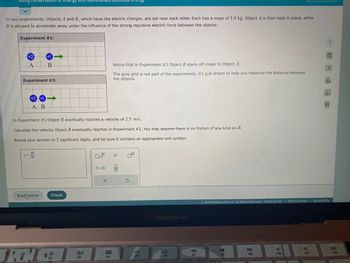
College Physics
11th Edition
ISBN: 9781305952300
Author: Raymond A. Serway, Chris Vuille
Publisher: Cengage Learning
expand_more
expand_more
format_list_bulleted
Concept explainers
Question

Transcribed Image Text:Using conservation of energy
In two experiments, Objects A and B, which have like electric charges, are set near each other. Each has a mass of 1.0 kg. Object A is then held in place, while
B is allowed to accelerate away under the influence of the strong repulsive electric force between the objects:
Experiment #1:
+2
A
V=
Experiment #2:
+2 +1
A B
+1
B
Explanation
+1->>
In Experiment #1 Object B eventually reaches a velocity of 2.5 m/s.
Calculate the velocity Object B eventually reaches in Experiment #2. You may assume there is no friction of any kind on B.
Round your answer to 2 significant digits, and be sure it contains an appropriate unit symbol.
Check
JANC
F2
80
F3
0.0
X
F4
ential energy
Notice that in Experiment #2 Object B starts off closer to Object A.
The gray grid is not part of the experiments, it's just drawn to help you measure the distance between
the objects.
3 00
F
0²
S
F5
MacBook Air
F6
F7
DII
F8
© 2023 McGraw Hill LLC. All Rights Reserved. Terms of Use | Privacy Center | Accessibility
F9
A
F10
J
?圖□f 图
F11
Ar
F12
Expert Solution
This question has been solved!
Explore an expertly crafted, step-by-step solution for a thorough understanding of key concepts.
This is a popular solution
Trending nowThis is a popular solution!
Step by stepSolved in 4 steps with 3 images

Knowledge Booster
Learn more about
Need a deep-dive on the concept behind this application? Look no further. Learn more about this topic, physics and related others by exploring similar questions and additional content below.Similar questions
- On planet #2, you launch a projectile straight up from the ground at a speed of 31.7 m/s. The projectile reaches a maximum height of 48.0 m before falling back to the ground. What is the value of g for planet #2? 20.94 m/s^2 36.34 m/s^2 72.68 m/s^2 10.47 m/s^2arrow_forwardO 0.2 MPa A 3500 Ib. car moving at 25 mi/h is accelerated at a constant rate of 15 ft/s^2^ up to a speed of 50 mi/h. What are the force and total time required? * O 1632 Ibf, 183 s O 7523 Ibf, 175 s O 52500 Ibf, 183 s O 7523 Ibf, 183 s O 1832 Ibf, 175 s O 2083 Ibf, 175 s • Document 14 5jpg O O O OO 0arrow_forwardA stationary 2.17-kg object is struck by a stick. The object experiences a horizontal force given by F = at - bt 2, where t is the time in seconds from the instant the stick first contacts the object. If a = 1,500,000 N/s and b = 20,000,000 N/s?, what is the speed of the object just after it comes away from the stick at t = 2.55 x 103 s? %3Darrow_forward
- Thor drops his hammer with a mass equal to 300 billion elephants off of Stark Tower (425 m). How fast will it be traveling just before it strikes the ground? part b - Tony Stark drops his lucky penny at the same time. How fast will his lucky penny be traveling just before it strikes the ground?arrow_forwardWhich of the following differential equations is the correct model if up is the positive direction? Consider an object of mass m that was thrown upwards and the magnitude of the force due to air resistance is 2v where v is the speed of the object in meters per second. pick (1) mv′=−mg−2v mv′=−mg+2v mv′=mg+2v mv′=mg−2varrow_forwardA brave but inadequate rugby player is being pushed backward by an opposing player who is exerting a force of 740 N on him. The mass of the losing player plus equipment is 88 kg, and he is accelerating at 1.8 m/s2 backward. Randomized Variables: f = 740 Nm1 = 88 kgm2 = 118 kga = 1.8 m/s2 1. What is the magnitude of the force of friction, in newtons, between the losing player's feet and the grass as he slides backwards? F1 = 2. What is the magnitude of the force, in newtons, that the winning player exerts on the ground to move forward if his mass plus equipment is 118 kg? Assume the second player has the same acceleration as the first. F2=arrow_forward
arrow_back_ios
arrow_forward_ios
Recommended textbooks for you
 College PhysicsPhysicsISBN:9781305952300Author:Raymond A. Serway, Chris VuillePublisher:Cengage Learning
College PhysicsPhysicsISBN:9781305952300Author:Raymond A. Serway, Chris VuillePublisher:Cengage Learning University Physics (14th Edition)PhysicsISBN:9780133969290Author:Hugh D. Young, Roger A. FreedmanPublisher:PEARSON
University Physics (14th Edition)PhysicsISBN:9780133969290Author:Hugh D. Young, Roger A. FreedmanPublisher:PEARSON Introduction To Quantum MechanicsPhysicsISBN:9781107189638Author:Griffiths, David J., Schroeter, Darrell F.Publisher:Cambridge University Press
Introduction To Quantum MechanicsPhysicsISBN:9781107189638Author:Griffiths, David J., Schroeter, Darrell F.Publisher:Cambridge University Press Physics for Scientists and EngineersPhysicsISBN:9781337553278Author:Raymond A. Serway, John W. JewettPublisher:Cengage Learning
Physics for Scientists and EngineersPhysicsISBN:9781337553278Author:Raymond A. Serway, John W. JewettPublisher:Cengage Learning Lecture- Tutorials for Introductory AstronomyPhysicsISBN:9780321820464Author:Edward E. Prather, Tim P. Slater, Jeff P. Adams, Gina BrissendenPublisher:Addison-Wesley
Lecture- Tutorials for Introductory AstronomyPhysicsISBN:9780321820464Author:Edward E. Prather, Tim P. Slater, Jeff P. Adams, Gina BrissendenPublisher:Addison-Wesley College Physics: A Strategic Approach (4th Editio...PhysicsISBN:9780134609034Author:Randall D. Knight (Professor Emeritus), Brian Jones, Stuart FieldPublisher:PEARSON
College Physics: A Strategic Approach (4th Editio...PhysicsISBN:9780134609034Author:Randall D. Knight (Professor Emeritus), Brian Jones, Stuart FieldPublisher:PEARSON

College Physics
Physics
ISBN:9781305952300
Author:Raymond A. Serway, Chris Vuille
Publisher:Cengage Learning

University Physics (14th Edition)
Physics
ISBN:9780133969290
Author:Hugh D. Young, Roger A. Freedman
Publisher:PEARSON

Introduction To Quantum Mechanics
Physics
ISBN:9781107189638
Author:Griffiths, David J., Schroeter, Darrell F.
Publisher:Cambridge University Press

Physics for Scientists and Engineers
Physics
ISBN:9781337553278
Author:Raymond A. Serway, John W. Jewett
Publisher:Cengage Learning

Lecture- Tutorials for Introductory Astronomy
Physics
ISBN:9780321820464
Author:Edward E. Prather, Tim P. Slater, Jeff P. Adams, Gina Brissenden
Publisher:Addison-Wesley

College Physics: A Strategic Approach (4th Editio...
Physics
ISBN:9780134609034
Author:Randall D. Knight (Professor Emeritus), Brian Jones, Stuart Field
Publisher:PEARSON